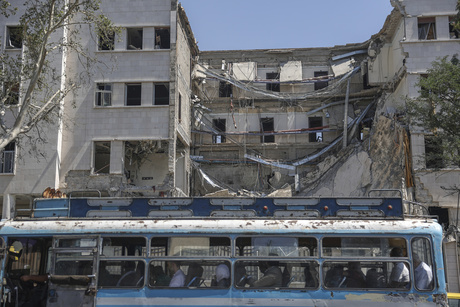Syrian forces withdraw from Sweida after ceasefire goes into effect

Syrian government forces largely withdrew from the southern province of Sweida Thursday following days of vicious clashes with militias of the Druze minority.
Under a ceasefire agreement reached the day before, which largely halted the hostilities, Druze factions and clerics have been appointed to maintain internal security in Sweida, Syria's interim President Ahmad al-Sharaa said in an address broadcast early Thursday.
The dayslong fighting threatened to unravel Syria's postwar political transition and brought in further military intervention by its powerful neighbor Israel, which on Wednesday struck the Syrian Defense Ministry headquarters in the heart of Damascus. Israel said it was acting to protect the Druze religious minority.
Druze leaders and Syrian government officials reached a ceasefire deal mediated by the United States, Turkey and Arab countries.
Convoys of government forces started withdrawing from the city of Sweida overnight as Syrian state media said the withdrawal was in line with the ceasefire agreement and the military operation against the Druze factions had ended.
It remained unclear if the ceasefire would hold after the agreement was announced by Syria's Interior Ministry and in a video message by a Druze religious leader. A previous agreement Tuesday quickly broke down after being dismissed by prominent Druze cleric Sheikh Hikmat Al-Hijri.
The escalation in Syria began with tit-for-tat kidnappings and attacks between local Sunni Bedouin tribes and Druze armed factions in the southern province of Sweida. Government forces that intervened to restore order clashed with the Druze militias, but also in some cases attacked civilians.
The Syrian government has not issued a casualty count from the clashes, but some rights groups and monitors say dozens of combatants on both sides have been killed, as well as dozens of largely Druze civilians killed in sectarian attacks.
Syrian Observatory for Human Rights, a Britain-based war monitor, says at least 374 combatants and civilians were killed in the clashes and Israeli strikes, among them dozens of civilians killed in the crossfire or in targeted attacks against the minority group.
Videos circulated on social media showed government forces and allies humiliating Druze clerics and residents, looting homes and killing civilians hiding inside their houses. Syrian Druze from Sweida told The Associated Press that several family members who were unarmed had been attacked or killed.
Al-Sharaa appealed to them in his address and vowed to hold perpetrators to account.
"We are committed to holding accountable those who wronged our Druze brethren," he said, calling the Druze an "integral part of this nation's fabric" who are under the protection of state law and justice, which safeguards the rights of everyone without exception.
The Druze community had been divided over how to approach al-Sharaa's de facto Islamist rule over Syria after largely celebrating the downfall of Bashar Assad and his family's decades-long dictatorial rule. They feared persecution after several attacks from the Islamic State militant group and al-Qaeda-affiliates the Nusra Front during Syria's 14-year civil war.
While it first appeared many Druze hoped to resolve matters diplomatically, with al-Sharaa promising an inclusive Syria for all its different communities, over time they became more skeptical, especially after a counterinsurgency in the coastal province in February turned into targeted attacks against the Alawite religious minority.
The Druze religious sect began as a 10th-century offshoot of Ismailism, a branch of Shiite Islam. More than half of the roughly 1 million Druze worldwide live in Syria. Most of the other Druze live in Lebanon and Israel, including in the Golan Heights, which Israel captured from Syria in the 1967 Mideast War and annexed in 1981.



